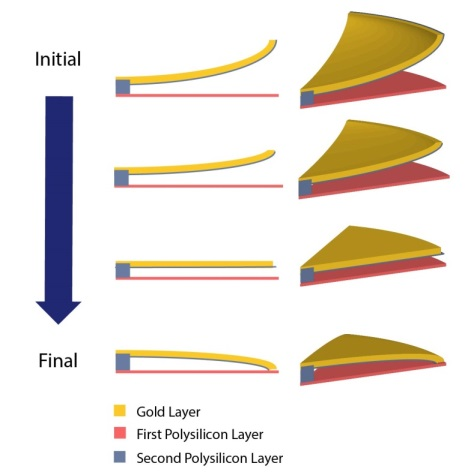Optical MEMS for Dynamic Lighting
 In almost all lighting applications, the distribution of light from the source is fixed in time. Lights can be turned on and off and/or dimmed but the distribution of the photons that do leave the source is generally static. Our research focuses on using microelectromechanical systems (MEMS) to allow for spatial division multiplexing within solid state lighting. These systems allow for lighting that is able to adapt as occupants move around the room on time scales which are imperceptible to the human eye. In addition to steering the light, the optical MEMS are capable of focal length variation so the light reflected from the mirror can be shaped (either focused or diffused) dynamically.
In almost all lighting applications, the distribution of light from the source is fixed in time. Lights can be turned on and off and/or dimmed but the distribution of the photons that do leave the source is generally static. Our research focuses on using microelectromechanical systems (MEMS) to allow for spatial division multiplexing within solid state lighting. These systems allow for lighting that is able to adapt as occupants move around the room on time scales which are imperceptible to the human eye. In addition to steering the light, the optical MEMS are capable of focal length variation so the light reflected from the mirror can be shaped (either focused or diffused) dynamically.
The micromirrors are composed of a series of thin film wedges, shown at the right, that change shape as they using electrothermal properties of thin film bimorphs. The bimorphs are composed of two layers, gold and polysilicon. The gold layer has a higher coefficient of thermal expansion than the polysilicon layer beneath it. An applied DC voltage supplies power dissipation, heating the device resulting in a dynamic focal length as the gold layer expands more than the polysilicon layer.
 In the same manner, bimorph legs attached to the center plate shown to the left are actuated electrothermally. Each bimorph leg, when actuated, pulls the plate closer to the substrate, deflecting the beam along one axis. Deflections up to ±40° have been shown and can be demonstrated simultaneously with focal length variation from less than 1 mm concave in shape to a convex 16 mm.
In the same manner, bimorph legs attached to the center plate shown to the left are actuated electrothermally. Each bimorph leg, when actuated, pulls the plate closer to the substrate, deflecting the beam along one axis. Deflections up to ±40° have been shown and can be demonstrated simultaneously with focal length variation from less than 1 mm concave in shape to a convex 16 mm.
Contact Information
Graduate Student: Jessica Morrison
PI: David Bishop

